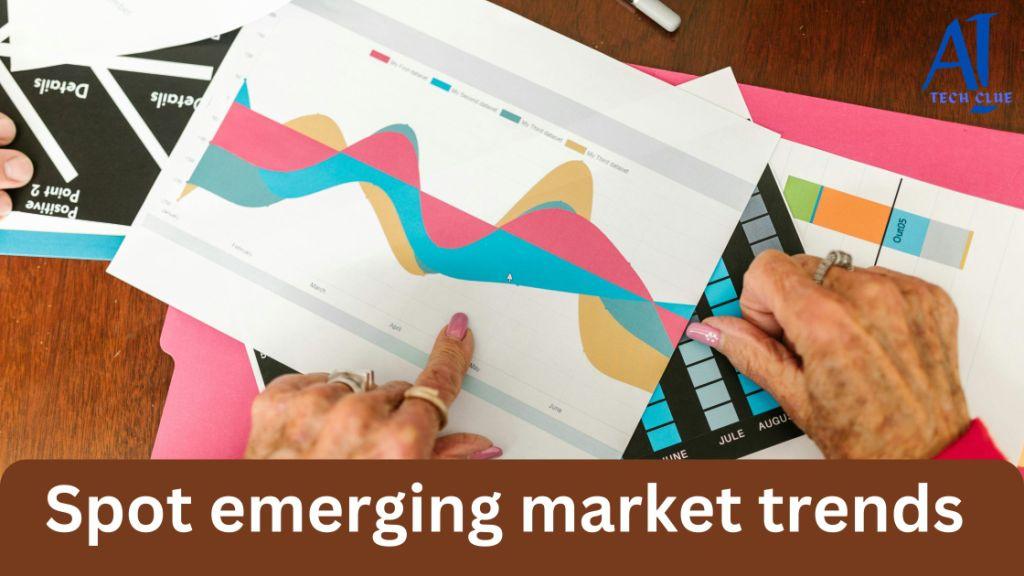Introduction to Spotting Emerging Market Trends
In the fast-paced world of investing and business, identifying emerging market trends before everyone else can be a game-changer. Spotting these trends early can give you a significant edge over competitors, allowing you to ride the wave of growth and avoid overcrowded, saturated markets. Whether you’re an investor, entrepreneur, or simply a keen observer of markets, knowing how to find the next big thing is a valuable skill.
If you want to read same article in hindi click here
What Are Emerging Market Trends?
Emerging market trends are patterns, ideas, or movements in industries or economies that are just beginning to gain traction. These trends haven’t yet hit the mainstream, meaning fewer people are aware of them, and their full potential hasn’t been realized. Spotting these early trends allows you to capitalize on them before the majority of people do.
Unlike established trends that everyone is talking about, emerging trends are still flying under the radar. They are characterized by innovation, evolving consumer behavior, or macro-economic shifts. By identifying these early, you can position yourself to benefit from their eventual growth.
Importance of Identifying Emerging Trends

Gaining First-Mover Advantage
Being first to identify a new trend means you can take advantage of opportunities before the market becomes saturated. This first-mover advantage allows you to make higher profits with less competition. For example, early adopters of technology stocks in the 1990s saw tremendous growth compared to those who entered the market later.
Higher Potential for Growth
Emerging trends often present higher growth potential because they are still in their infancy. The market hasn’t fully matured, meaning there’s more room for growth and expansion. Early investors in trends like electric vehicles or renewable energy have benefited from this potential.
Avoiding Market Saturation
Once a trend becomes mainstream, the market gets crowded, and growth slows down. By spotting trends early, you avoid entering markets that are already oversaturated with competition, which often results in reduced profit margins.
How to Identify Emerging Market Trends
Analyze Industry Reports and Data
One of the best ways to identify emerging market trends is to dive into industry reports and data. Research firms often publish insights that highlight shifts in markets or emerging opportunities. Look for patterns in consumer behavior, technological advancements, or industry disruptions.
Follow Market Influencers and Thought Leaders
Thought leaders and industry influencers often have their finger on the pulse of emerging trends. By following experts on platforms like LinkedIn, Twitter, and financial news outlets, you can stay ahead of the curve. Many of these influencers share insights into where they think the market is headed and what industries are ripe for growth.
Monitor Social Media and Online Forums
Social media platforms and online forums like Reddit can provide early signals of market shifts. Communities on these platforms are quick to discuss new technologies, ideas, and trends before they hit the mainstream. Watch out for repeated mentions of a new product, service, or technology, as this could indicate an emerging trend.
Analyzing Macro-Economic Indicators
GDP Growth and Its Influence on Trends
Macro-economic indicators, like GDP growth, can signal the emergence of new trends. Countries with fast-growing economies often present new investment opportunities. For example, rapid GDP growth in China and India has been a precursor to emerging consumer markets in these countries.
Inflation, Interest Rates, and Consumer Behavior
Inflation and interest rates directly impact consumer behavior, which in turn can signal the rise of new trends. For example, periods of low interest rates often lead to increased investment in real estate or equities. Understanding how these indicators influence spending habits can help you predict future trends.
The Impact of Technological Advancements
Technological innovation is a key driver of emerging trends. Keeping an eye on new technologies and how they’re adopted across different sectors can help you identify the next big thing. Think about how the internet revolutionized industries in the late 1990s or how AI is impacting various sectors today.
Leveraging Technology to Spot Trends
Use AI and Machine Learning Tools
Artificial intelligence and machine learning can analyze vast amounts of data to spot emerging trends that the human eye might miss. These tools can identify patterns, correlations, and predictions from a sea of market data. Investors are increasingly using AI-driven platforms to track new opportunities before they become apparent to the general market.
Data Analytics and Predictive Models
Using data analytics and predictive models can help you make informed predictions about future market trends. Tools that analyze search data, consumer purchasing habits, or sentiment analysis can offer early insights into emerging market movements.
The Role of Sentiment Analysis in Trend Spotting
Sentiment analysis tools that track how people feel about certain products, brands, or technologies can offer early clues to emerging trends. A rise in positive sentiment about a specific sector or company could be a sign of future growth.
Studying Consumer Behavior for Early Signals
The Rise of New Consumer Demands
Paying attention to shifts in consumer preferences can help you identify emerging trends. For example, the growing demand for eco-friendly products has led to the rise of sustainable brands and green technologies. When consumers start asking for new products or services, that’s often a signal that a new trend is emerging.
The Importance of Demographic Shifts
Changes in demographics, such as the aging population or the rise of Millennials and Gen Z as major consumers, can shape new trends. Understanding how these groups spend their money and what they value can help you stay ahead of the curve.
Tracking Shifts in Purchasing Patterns
Purchasing patterns change as new technologies or products enter the market. By analyzing how people spend their money, you can get an early sense of what’s becoming popular.
For instance, the shift to online shopping in the early 2000s signaled the rise of e-commerce.
Keeping an Eye on Startups and Innovations
Why Startups Often Signal Emerging Trends
Startups are often at the forefront of innovation. These small, agile companies are quick to adapt to changes in the market and are often the first to capitalize on new trends. Watching which startups are gaining attention or funding can provide early clues to emerging market trends.
Monitoring Venture Capital and Funding Trends
Where venture capital money flows, new trends often follow. Investors tend to pour money into sectors they believe will grow in the future. By tracking where venture capitalists are investing, you can identify the industries and technologies that are likely to emerge as major trends.
Attending Startup Conferences and Networking Events
Startup conferences and networking events are excellent opportunities to discover the next big thing. At these events, entrepreneurs and investors come together to discuss innovations and market shifts. By attending these events, you can gain valuable insights into what’s on the horizon.
The Role of Globalization in Emerging Trends
Trends Spreading Across Borders
Globalization means that trends can now spread across borders more quickly than ever before. A trend that starts in one country can rapidly move to others. For example, the rise of fintech in Asia has quickly made its way to Western markets.
How Global Markets Impact Local Trends
Global market movements can influence local trends. For example, the rise of electric vehicles in Europe and China has influenced demand in other markets. By paying attention to what’s happening globally, you can spot emerging trends in your local market before they take off.
How to Distinguish Between Fads and Sustainable Trends
Characteristics of a Long-Term Trend
A sustainable trend is one that is driven by fundamental changes in technology, consumer behavior, or economic shifts. These trends are backed by strong data and continue to grow over time, like the shift to renewable energy.
How to Spot a Short-Lived Fad
A fad, on the other hand, is often short-lived and driven by temporary consumer interest. Think of fidget spinners or viral TikTok products. Fads tend to die out quickly once the hype fades, leaving little long-term value for investors.
Making Educated Bets on Sustainability
When investing in emerging trends, it’s important to make educated bets on which ones will last. Look for trends that are solving real problems or meeting new demands in the market. Do your research and focus on data to distinguish between sustainable trends and fleeting fads.
Case Studies of Successful Trend Spotters
Examples of Investors Who Identified Trends Early
Many successful investors have made their fortunes by spotting trends before everyone else. For example, those who invested early in tech companies like Apple and Amazon reaped massive rewards as these companies grew to dominate their industries.
Lessons Learned from Market Leaders
Market leaders often share their strategies for identifying trends. Their insights can help you develop your own approach to trend spotting. One key lesson is the importance of staying curious and constantly seeking out new information.
How to Position Yourself for Future Trends
Diversifying Your Portfolio
When positioning yourself for future trends, diversification is key. By spreading your investments across multiple emerging trends, you reduce the risk of putting all your eggs in one basket. This strategy ensures that even if one trend doesn’t take off, others will keep your portfolio healthy.
Taking Calculated Risks
Investing in emerging trends always carries some level of risk. However, by conducting thorough research and using data to guide your decisions, you can take calculated risks that offer the potential for high returns.
The Importance of Agility and Flexibility in Investing
Being able to adapt quickly to new information is crucial when investing in emerging trends. Markets can change rapidly, and those who are agile and flexible in their approach are often the ones who succeed. Stay open to new ideas and be willing to adjust your strategy as needed.
Common Pitfalls to Avoid When Spotting Trends
Falling for Hype Without Data
One of the biggest mistakes investors make is falling for hype without backing it up with solid data. Just because everyone is talking about a new trend doesn’t mean it’s a good investment. Always rely on research and evidence to guide your decisions.
Over-Committing to a Single Trend
While it’s tempting to go all-in on a trend you believe in, over-committing to a single trend can be risky. If the trend doesn’t pan out, you could face significant losses. Spread your investments across multiple emerging trends to mitigate this risk.
Ignoring Signs of a Trend Reversing
Trends don’t last forever, and one of the key skills in spotting emerging trends is knowing when to exit. If the data suggests that a trend is reversing, it’s better to cut your losses early rather than holding on in the hope that it will recover.
Tools and Resources for Tracking Emerging Trends
Best Websites and Tools for Trend Analysis
There are plenty of online resources that can help you track emerging trends. Websites like Crunchbase, PitchBook, and CB Insights offer data on startups and funding trends. Financial news outlets like Bloomberg and Reuters also provide insights into global market movements.
Financial Publications and Industry Reports
Subscribing to financial publications like The Wall Street Journal or The Economist can provide valuable information on emerging market trends. These publications often feature in-depth analyses of industries and economies, giving you a deeper understanding of where trends are headed.
Using Google Trends and Other Free Tools
Google Trends is a free tool that allows you to track search interest in specific topics over time. By monitoring the rise and fall of interest in certain keywords, you can gain early insights into emerging trends. Other free tools like social media listening platforms can also provide valuable data.
Conclusion
Spotting emerging market trends before everyone else requires a combination of research, intuition, and technological tools. By keeping a close eye on macro-economic indicators, studying consumer behavior, leveraging AI, and staying agile in your investment strategy, you can position yourself to capitalize on the next big thing. The key is to remain curious, constantly seek out new information, and use data to make informed decisions. The earlier you can identify a trend, the greater the potential rewards.
The role of behavioral finance in stock market decisions
FAQs
1: How long does it take for a trend to become mainstream?
Emerging trends can take anywhere from a few months to several years to reach the mainstream, depending on factors like market adoption, technological advancement, and consumer behavior.
2: What’s the best way to confirm if a trend is sustainable?
The best way to confirm if a trend is sustainable is to look for strong underlying data and a clear market need. Trends that solve real problems or meet significant demand are more likely to last.
3: How can I get better at spotting trends early?
Improving your trend-spotting skills requires staying informed, conducting research, and following industry experts. The more you immerse yourself in market data and news, the better you’ll get at identifying trends early.
4: Can I invest in trends without taking on too much risk?
Yes, you can mitigate risk by diversifying your investments across multiple trends and by using data to make informed decisions. Focus on trends that have strong market potential and clear signals of growth.
5: What are some emerging market trends to watch right now?
Some emerging market trends to watch in 2024 include AI-driven automation, green energy solutions, electric vehicles, and the rise of the metaverse in various industries.


3 thoughts on “How to Spot Emerging Market Trends Before Everyone Else”